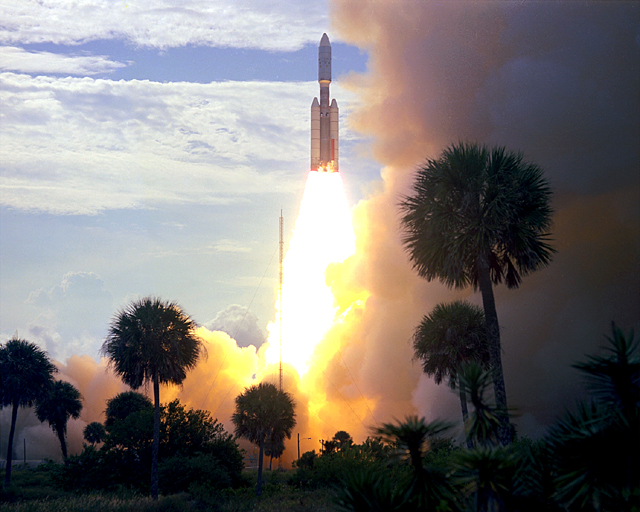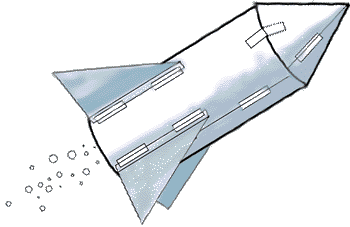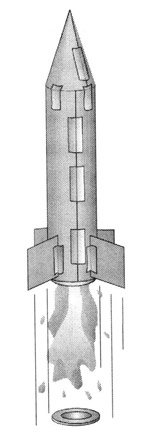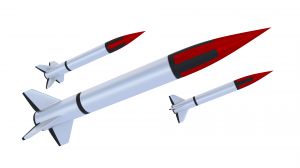Class Activity: 3-2-1 Pop!
(This activity combines material from NASA Quest and NASA activity pages. Suggested Level: Grades 5-8; can be modified for younger students. Time required: 40 – 45 minutes.)

In this simple, exciting demonstration of Newton’s Laws of Motion, students grades 5-8 construct a rocket powered by the pressure generated from an effervescing antacid tablet reacting with water. Introduced to aerospace engineering, they explore design elements that can affect how planes and rockets perform.
The rocket lifts off because it is acted upon by an unbalanced force (First Law), produced when the lid blows off by the gas formed in the canister. The rocket travels upward with a force that is equal and opposite to the downward force propelling the water, gas, and lid (Third Law). The amount of force is directly proportional to the mass of water and gas expelled from the canister and how fast it accelerates (Second Law). For a more complete discussion of Newton’s Laws of Motion, see Rocket Principles.
Objective
To demonstrate how rocket liftoff is an application of Newton’s Laws of Motion.
Description
 Students construct a rocket powered by the pressure generated from an effervescing antacid tablet reacting with water.
Students construct a rocket powered by the pressure generated from an effervescing antacid tablet reacting with water.
When the fizzy tablet is placed in water, bubbles of gas escape. The bubbles go up, instead of down, because they weigh less than water. When the bubbles get to the surface of the water, they break open. The bubbles’ escaping gas pushes on the sides of the canister, ultimately forcing the canister lid to pop off.
The water and gas rush down and out, pushing the canister up and up, along with the rocket attached to it. Real rockets work in a similar fashion, using rocket fuel instead of fizzing tablets.
Science Standards
• Physical Science – Position and motion of objects
• Science and Technology – Abilities of technological design – Understanding about science and technology
Materials and Tools
• Student sheets:
3-2-1 Pop! Page 1
3-2-1 Pop! Page 2
• Heavy paper (60-110 index stock or construction paper)
• Plastic 35 mm film canister (The film canister must have an internal-sealing lid. See management section, below, for details.)
• Cellophane tape
• Scissors
• Effervescing antacid tablet
• Paper towels
• Water
• Eye protection (eye glasses, sun glasses, or safety goggles)
Management

For best results, students should work in pairs. Teachers can prepare samples of rockets in various stages of completion to help students visualize the construction steps.
A single sheet of paper is sufficient to make a rocket. Be sure to tell the students to plan how they are going to use their sheet, allowing them to decide whether to cut it the short or long direction when making the rocket’s body tube. This will lead to rockets of different lengths for flight comparison.
The most common mistakes in constructing the rocket are: forgetting to tape the film canister to the rocket body; failing to mount the canister with the lid end down; not extending the canister far enough from the paper tube to make snapping the lid easy; and using excessive paper or tape, which produces less efficient fliers because they carry additional weight.
Some students also may have difficulty forming the cone. To make a cone, cut out a “Pacman” shape from a circle and curl it into a cone. See the pattern for help; cones can be any size.
Film canisters are available from camera shops and stores where photographic processing takes place. These businesses recycle the canisters and are often willing to donate them for educational use. Be sure to obtain canisters with the internal sealing lid. These are usually translucent canisters. Canisters with external lids, which wrap around the canister rim, will not work. These are often opaque canisters.
Procedure
Review the Rocket Principles page and Newton’s laws and download the full lesson pdf and student sheets, or refer to the online material and the additional NASA activity page.
Distribute student sheets and help students set up for the activity.
Engage students in discussion before, during, and after the activity, to help them understand its process:
• How does the amount of water placed in the cylinder affect how high the rocket will fly?
• How does the temperature of the water affect how high the rocket will fly?
• How does the amount of the tablet used affect how high the rocket will fly?
• How does the length or empty weight of the rocket affect how high the rocket will fly?
• How would it be possible to create a two-stage rocket?
Student Instructions
Preparation:
1. Cut out all the pieces for your rocket.
2. Wrap and tape a tube of paper around the film canister. Hint: Tape the canister to the end of the paper before you start wrapping, and avoid using too much tape, as it will produce a heavier rocket. Important! Place the lid end of the canister down.
3. Tape fins to your rocket body, if you wish.
4. Roll the circle (with a wedge cut out) into a cone and tape it to the rocket’s top.

Blasting Off
1. Put on your eye protection.
2. Turn the rocket upside down and remove the canister’s lid.
3. Fill the canister one-third full of water.
Work quickly on the next steps:
4. Drop one-half of an effervescing antacid tablet into the canister.
5. Snap the lid on tight.
6. Stand your rocket on a stable launch platform with space around it, such as a sidewalk or driveway.
7. Stand back and wait. Your rocket will blast off!
Assessment
Ask students to explain how Newton’s Laws of Motion apply to this rocket. Compare the rockets for skill in construction.
Extensions
• Hold an altitude contest to see which rockets fly the highest. Launch the rockets near a wall in a room with a high ceiling. Tape a tape measure to the wall. Stand back and observe how high the rockets travel upward along the wall. Let all students take turns measuring rocket altitudes.
• Use the discussion questions to design further experiments with the rockets. Have students graph their results.
• Introduce students to the eGFI aerospace page and the work of aerospace engineers as they seek to design lighter air- and space-craft to reduce green house gas emissions. They can also explore the eGFI blog for recent developments in aerospace technology.
Filed under: Class Activities, Grades 6-8, Grades K-5
Tags: Aerospace, grades 5-8, NASA, Newton's Laws








